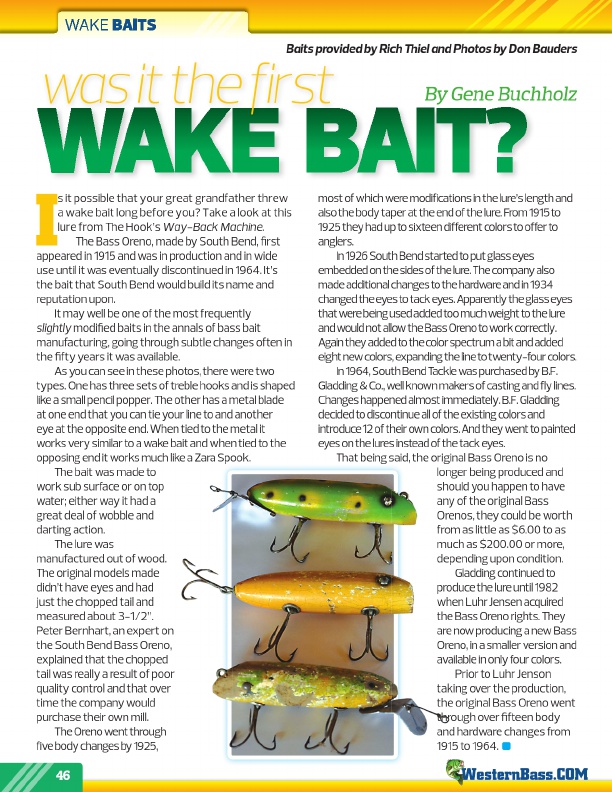
WAKE baITS
Baits provided by rich Thiel and Photos by Don Bauders
wakE baIT?
was it the first
By Gene Buchholz
I
s it possible that your great grandfather threw
a wake bait long before you? Take a look at this
lure from The Hook’s Way-Back Machine .
The Bass Oreno, made by South Bend, first appeared in 1915 and was in production and in wide
most of which were modifications in the lure’s length and also the body taper at the end of the lure. From 1915 to 1925 they had up to sixteen different colors to offer to anglers.
In 1926 South Bend started to put glass eyes
use until it was eventually discontinued in 1964. It’s
embedded on the sides of the lure. The company also
the bait that South Bend would build its name and
made additional changes to the hardware and in 1934
reputation upon.
changed the eyes to tack eyes. Apparently the glass eyes
It may well be one of the most frequently
that were being used added too much weight to the lure
slightly modified baits in the annals of bass bait
and would not allow the Bass Oreno to work correctly.
manufacturing, going through subtle changes often in Againtheyaddedtothecolorspectrumabitandadded
the fifty years it was available.
eight new colors, expanding the line to twenty-four colors.
As you can see in these photos, there were two
In 1964, South Bend Tackle was purchased by B.F.
types. One has three sets of treble hooks and is shaped Gladding&Co.,wellknownmakersofcastingandflylines.
like a small pencil popper. The other has a metal blade
Changes happened almost immediately. B.F. Gladding
at one end that you can tie your line to and another
decided to discontinue all of the existing colors and
eye at the opposite end. When tied to the metal it
introduce 12 of their own colors. And they went to painted
works very similar to a wake bait and when tied to the
eyes on the lures instead of the tack eyes.
opposing end it works much like a Zara Spook.
That being said, the original Bass Oreno is no
The bait was made to
longer being produced and
work sub surface or on top
should you happen to have
water; either way it had a
any of the original Bass
great deal of wobble and
Orenos, they could be worth
darting action.
from as little as $6.00 to as
The lure was
much as $200.00 or more,
manufactured out of wood.
depending upon condition.
The original models made
Gladding continued to
didn’t have eyes and had
produce the lure until 1982
just the chopped tail and
when Luhr Jensen acquired
measured about 3-1/2”.
the Bass Oreno rights. They
Peter Bernhart, an expert on
are now producing a new Bass
the South Bend Bass Oreno,
Oreno, in a smaller version and
explained that the chopped
available in only four colors.
tail was really a result of poor
Prior to Luhr Jenson
quality control and that over
taking over the production,
time the company would
the original Bass Oreno went
purchase their own mill.
through over fifteen body
The Oreno went through
and hardware changes from
five body changes by 1925,
1915 to 1964.
46